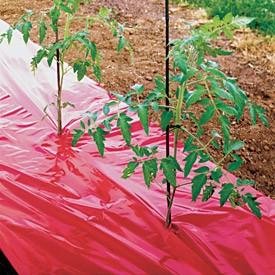Review: Red Plastic Mulch for Tomatoes –Does It Make a Difference?
Since 2010, Tomato Dirt has garnered 4.8+ million views, making it the web’s leading online source for growing tomatoes in the home garden. Award-winning writer and Tomato Dirt owner Kathy Widenhouse has helped thousands of home gardeners grow healthier tomatoes. Be one of them when you get Tomato Dirt’s Growing Guide here.
Red plastic mulch was actually not introduced as mulch. Rather, its developers (USDA’s plant physiologist Michael J. Kasperbauer and Clemson University nematologist Bruce Fornum) found that it increased yields up to 20%. It was first recommended to commercial farmers, rather than home gardeners, who could benefit from higher production on a larger scale.
Along the way, gardeners began referring to red plastic tomato mulch as a mulching option.
While the product is not technically mulch, it’s increasingly used as one. Red plastic mulch (also known as Selective Reflecting Mulch, or SRM for short) is similar to black plastic mulch in that it warms the soil, prevents erosion, and retains moisture. It’s thinner than most garden plastic, allowing more light (and sometimes weeds) through.
But red plastic mulch’s touted strength is in its ability to reflect certain red shades of light back into the plant, accelerating fruit production and increasing yield.
How red plastic mulch works
There are pigments in tomato plants called phytochromes. They are color-sensitive proteins. Their job is to regulate plant growth and development.
Phytochromes react differently to different spectra of light. Specifically, when far-red light wavelengths from the plastic bounce back up to tomato plants, the phytochromes tell the tomato fruit to grow more and faster.
That’s why gardeners say setting out red plastic mulch around their tomato plants makes their tomatoes ripen faster and produce bigger fruit.
Naturally, the amount of light reflected depends on growing conditions. Also, the plastic color must be specific. In other words, just any color of red plastic may not give good results, but rather those which have been developed and tested for this purpose. Recent studies suggest that other colors of plastic may offer greater yields than black, too, particularly blue plastic.
Bonus benefit: red tomato mulch deters nematodes
Additional studies have documented that red plastic mulch also reduces nematode damage. Nematodes (specifically, root knot nematodes) are worms that feed on a tomato’s root system. They are a particular problem in areas where the ground does not freeze, because they continue to live in the soil all year long.
A study by the USDA’s Agricultural Research Service found that red plastic mulch suppresses root nematode damage to tomatoes because the light reflection keeps more of the plant’s growth above ground. The plant’s energy goes into developing fruit and foliage, rather than roots. Nematodes feed on roots. The far-red light reflection to the above-ground plant draws away nutrients from the roots – and nutrients away from the nematodes. Fewer roots mean less food for nematodes. Less food = fewer nematodes.
Red tomato mulch options
Red plastic is available to home gardeners in rolls of various lengths. If you look hard you can find it in oversized squares, which is well suited for container tomatoes or for gardens with just a few tomato plants. If you have a larger number of tomatoes, rolls are the more economical choice.
Advantages of red plastic mulch
- Bigger tomatoes
- More tomatoes
- Warms the soil
- Manageable for the home gardener, especially where smaller coverage needed
- Retains moisture in pots, a perennial problem
For best results …
- Allow several feet of the red showing on either side of the plant or row.
- Use determinate tomato plants -- their finite size means they may maximize the amount of light reflected from the plastic.
- Run a drip hose underneath plastic, because the plastic forms a strong barrier. Water tends to pool on plastic surface even though it eventually penetrates.
(Browse different types of red plastic mulch.)
When it comes to red plastic, be aware of this
More than four out of five gardeners who use red tomato mulch would recommend it to a friend. Even so, there are some cautions.
- Plan a watering method. The red tomato mulch offered by Gardener’s Supply has extra holes (“micro-perforations”) to allow water and air easily into the soil, but they’re tiny. Water can pool on the plastic in dips and valleys and stagnate. Some gardeners run drip hoses beneath the plastic to make sure plants get adequate water. (Gardeners who use black plastic do this too.)
- Handle carefully. Red plastic is thin and can tear easily. On average, it lasts two or three seasons. But there have been gardeners who handle it carefully and have used it up to 7 years.
- Replace it. When the plants get so big that no direct light hits the red plastic, switch it out and put down another type of mulch for the remainder of the season. You’ll save wear and tear on the red plastic for next season.
More on mulching tomatoes
When to Mulch Tomatoes for Best Results...
Black plastic mulch for tomatoes ...
Review: Woven weed mats for mulching tomatoes ...
Review: Biodegradable weed mats for mulching tomatoes...
How and when to mulch tomatoes ...
What's the best mulch for tomatoes?
Get more mulching ideas on our Mulching Tomatoes Pinterest board...
Return from Review: Red Plastic Mulch to Tomato Dirt home
As an Amazon Associate and Rakuten Advertising affiliate I earn from qualifying purchases.
SHARE THIS PAGE:
FREE! 10 Must-Know Tomato Growing Tips: 20-page guide
Get yours here:





New! Comments
Have your say about what you just read! Leave a comment in the box below.